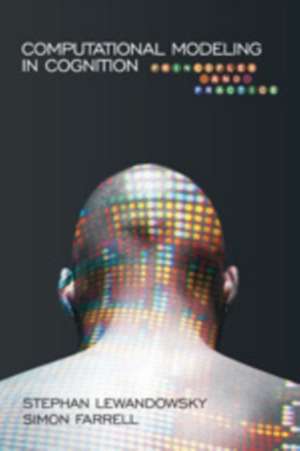Computational Modeling in Cognition: Principles and Practice
Autor Stephan Lewandowsky, Simon Farrellen Limba Engleză Paperback – 24 ian 2011
Preț: 464.43 lei
Preț vechi: 938.31 lei
-51% Nou
Puncte Express: 697
Preț estimativ în valută:
88.87€ • 91.82$ • 73.93£
88.87€ • 91.82$ • 73.93£
Carte indisponibilă temporar
Doresc să fiu notificat când acest titlu va fi disponibil:
Se trimite...
Preluare comenzi: 021 569.72.76
Specificații
ISBN-13: 9781412970761
ISBN-10: 1412970768
Pagini: 376
Ilustrații: Illustrations
Dimensiuni: 152 x 229 x 20 mm
Greutate: 0.5 kg
Ediția:1
Editura: SAGE Publications
Colecția Sage Publications, Inc
Locul publicării:Thousand Oaks, United States
ISBN-10: 1412970768
Pagini: 376
Ilustrații: Illustrations
Dimensiuni: 152 x 229 x 20 mm
Greutate: 0.5 kg
Ediția:1
Editura: SAGE Publications
Colecția Sage Publications, Inc
Locul publicării:Thousand Oaks, United States
Recenzii
"[T]his is an excellent introduction to computational modeling. It is written at exactly the right level for its intended readership, and it covers all the essentials very well. I can only encourage anyone with an interest in cognition to work with this book."
Cuprins
Preface
1. Introduction
1.1 Models and Theories in Science
1.2 Why Quantitative Modeling?
1.3 Quantitative Modeling in Cognition
1.4 The Ideas Underlying Modeling and Its Distinct Applications
1.5 What Can We Expect From Models?
1.6 Potential Problems
2. From Words to Models: Building a Toolkit
2.1 Working Memory
2.2 The Phonological Loop: 144 Models of Working Memory
2.3 Building a Simulation
2.4 What Can We Learn From These Simulations?
2.5 The Basic Toolkit
2.6 Models and Data: Sufficiency and Explanation
3. Basic Parameter Estimation Techniques
3.1 Fitting Models to Data: Parameter Estimation
3.2 Considering the Data: What Level of Analysis?
4. Maximum Likelihood Estimation
4.1 Basics of Probabilities
4.2 What Is a Likelihood?
4.3 Defining a Probability Function
4.4 Finding the Maximum Likelihood
4.5 Maximum Likelihood Estimation for Multiple Participants
4.6 Properties of Maximum Likelihood Estimators
5. Parameter Uncertainty and Model Comparison
5.1 Error on Maximum Likelihood Estimates
5.2 Introduction to Model Selection
5.3 The Likelihood Ratio Test
5.4 Information Criteria and Model Comparison
5.5 Conclusion
6. Not Everything That Fits Is Gold: Interpreting the Modeling
6.1 Psychological Data and The Very Bad Good Fit
6.2 Parameter Identifiability and Model Testability
6.3 Drawing Lessons and Conclusions From Modeling
7. Drawing It All Together: Two Examples
7.1 WITNESS: Simulating Eyewitness Identification
7.2 Exemplar Versus Boundary Models: Choosing Between Candidates
7.3 Conclusion
8. Modeling in a Broader Context
8.1 Bayesian Theories of Cognition
8.2 Neural Networks
8.3 Neuroscientific Modeling
8.4 Cognitive Architectures
8.5 Conclusion
References
Author Index
Subject Index
About the Authors
1. Introduction
1.1 Models and Theories in Science
1.2 Why Quantitative Modeling?
1.3 Quantitative Modeling in Cognition
1.4 The Ideas Underlying Modeling and Its Distinct Applications
1.5 What Can We Expect From Models?
1.6 Potential Problems
2. From Words to Models: Building a Toolkit
2.1 Working Memory
2.2 The Phonological Loop: 144 Models of Working Memory
2.3 Building a Simulation
2.4 What Can We Learn From These Simulations?
2.5 The Basic Toolkit
2.6 Models and Data: Sufficiency and Explanation
3. Basic Parameter Estimation Techniques
3.1 Fitting Models to Data: Parameter Estimation
3.2 Considering the Data: What Level of Analysis?
4. Maximum Likelihood Estimation
4.1 Basics of Probabilities
4.2 What Is a Likelihood?
4.3 Defining a Probability Function
4.4 Finding the Maximum Likelihood
4.5 Maximum Likelihood Estimation for Multiple Participants
4.6 Properties of Maximum Likelihood Estimators
5. Parameter Uncertainty and Model Comparison
5.1 Error on Maximum Likelihood Estimates
5.2 Introduction to Model Selection
5.3 The Likelihood Ratio Test
5.4 Information Criteria and Model Comparison
5.5 Conclusion
6. Not Everything That Fits Is Gold: Interpreting the Modeling
6.1 Psychological Data and The Very Bad Good Fit
6.2 Parameter Identifiability and Model Testability
6.3 Drawing Lessons and Conclusions From Modeling
7. Drawing It All Together: Two Examples
7.1 WITNESS: Simulating Eyewitness Identification
7.2 Exemplar Versus Boundary Models: Choosing Between Candidates
7.3 Conclusion
8. Modeling in a Broader Context
8.1 Bayesian Theories of Cognition
8.2 Neural Networks
8.3 Neuroscientific Modeling
8.4 Cognitive Architectures
8.5 Conclusion
References
Author Index
Subject Index
About the Authors
Descriere
A clear introduction to the principles of using computational and mathematical models in psychology and cognitive science.
